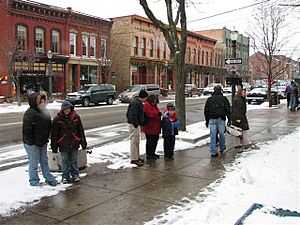Old Town, Lansing, Michigan facts for kids
Quick facts for kids
Old Town
|
|
|---|---|
 |
|
| Country | United States |
| State | Michigan |
| County | Ingham |
| Area | |
| • Total | 0.44 sq mi (1.1 km2) |
| Elevation | 860 ft (262 meters) ft (228 m) |
| Population
(2000)
|
|
| • Total | 1,654 |
| • Density | 3,708.5/sq mi (1,431.9/km2) |
| Time zone | UTC-5 (EST) |
| • Summer (DST) | UTC-4 (EDT) |
| ZIP codes |
48906
|
| Area code(s) | 517 |
| FIPS code | 26-80700 |
| GNIS feature ID | 1615125 |
| Website | http://www.iloveoldtown.org/ |
|
North Lansing Historic Commercial District
|
|
| Location | E. Grand River Ave. and Turner St., Lansing, Michigan |
| Area | 11 acres (4.5 ha) |
| Architectural style | Late 19th And 20th Century Revivals, Late Victorian, Vernacular Commercial |
| NRHP reference No. | 76001029 |
| Significant dates | |
| Added to NRHP | April 30, 1976 |
Old Town is a cool neighborhood located in the northern part of Lansing, Michigan. It sits right by the Grand River and a fun bike trail. This area is so special that it's listed on the National Register of Historic Places as the North Lansing Historic Commercial District. People started building here in the middle of the 1800s.
History of Old Town
The very first person to settle in North Lansing, which is now called Old Town, was John W. Burchard. He was a lawyer from Mason. In 1843, he built Lansing's first log cabin on land he bought from James Seymour.
Later that year, Burchard built a dam across the Grand River. He hoped to build a mill there, but sadly, he drowned at the dam in 1844 while checking on a break. James Seymour later built a mill in that same spot.
Growth and Development
The North Lansing area grew a lot when Lansing became the capital city of Michigan in 1847. More businesses and factories started to appear. By the 1870s, North Lansing was really busy and successful.
Franklin Street, which is now called Grand River Avenue, was the main street for businesses. It had banks, shops, grocery stores, churches, mills, and even a train station for people and goods. Many middle-class families lived there, supporting all the businesses.
Changes Over Time
However, by the mid-1900s, other parts of Lansing, like Upper Town and Middle Town, started attracting more people and businesses. North Lansing lost its top spot as a busy business and factory area.
In 1976, the North Lansing Historic Commercial District was added to the National Register of Historic Places. This district included 44 important buildings.
In recent years, the area known as Old Town has been working to become lively again. They use programs like Michigan Main Street to help bring new life and businesses to the neighborhood.
Fun Cultural Events
Old Town hosts many exciting events every year. These events bring people together to enjoy music, art, and community spirit.
- Old Town BluesFest: This is a two-day music festival that features amazing blues artists. It's free to attend and happens every September.
- Lansing JazzFest: Another fantastic two-day music festival, this one celebrates jazz music. It's also free and takes place every August.
- Scrapfest: This is an art festival where artists create amazing pieces from recycled and repurposed materials. A part of the money earned (10%) goes to charity. It happens every summer.

